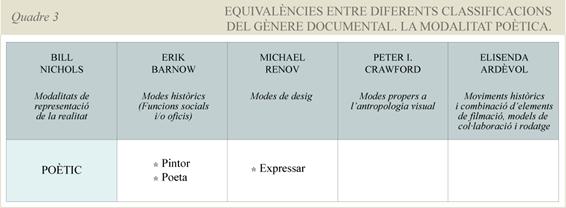DOCUMENTAL INTERACTIU - ARNAU GIFREU CASTELLS / PHD

escripció i característiques
Comparteix terreny amb l’avantguarda modernista
Sacrifica les convencions de la continuitat tempo-espacial i la sensació d’una localització específica en el temps i l’espai permet al mode l’exploració d’associacions i patrons qie inclou la creació i representació de ritmes temporals i juxtaposicions espacials.
Els actors socials agafen un rol semblant als dels actors de la ficció: poden tenir un caracter complex a nivell psicològic i un punt de vista rígid i fixe sobre el món (Nichols, 2001:102)
Per exemple, a la pel.lícula Regen de Joris Ivens, no coneixem cap actor social però apreciem la impressió lírica que Ivens crea a partir d’un xàfec passatger d’estiu a Amsterdam. (Nichols, 2001:103)
Es tracta d’una modalitat particularment oberta a la possibilitat d’adaptació cap a formes alternatives de coneixement […] Aquest mode força l’estat d’ànim i el to.
“The documentary dimension to the poetic mode of representation stems largely from the degree to which modernist films rely on the historical world for their source material. Some avant-garde films such as Oscar Fischinger’s Composition in Blue (1935) use abstract patterns of form or color or animated figures and have minimal relation to a documentary tradition of representing the historical world rather than a world of the artists imagining. Poetic documentaries, though, draw on the historical world for their raw material but transform this material in distinctive ways. Francis Thompson N.Y., N.Y. (1957), for example, uses shots of New York City that provide evidence of how New York looked in the mid-1950s but gives greater priority to how these shots can be selected and arranged to produce a poetic impression of the city as a mass of volume, color and movement. Thompson’s films continue the tradition of the city symphony films and affirms the poetic potential of documentary to see the historical world anew.”
El mode poètic comença paral.lelament amb el modernisme com una manera de representar la realitat en termes d’una sèrie de fragments, impressions subjectives, actes incoherents i associacions perdudes. Aquestes qualitats varen ser sovint atribuïdes a les transformacions sofertes per la industrialització en general, i als efectes de la 1ª Guerra Mundial en particular. El mode trenca el temps i l’espai a través de múltiples perspectives, nega la coherència entre personalitats vulnerables i irrupcions de l’incosncient, i refusa i dóna solucions. (Nichols, 2001:104)
“ Un Chien Andalou (Luis Buñuel and Salvador Dalí, 1928) and L’Age d’or (Luis Buñuel, 1930), for example, gave the impression of a documentary reality but then populated that reality with characters caught up in incontrolable urges, abrupt shifts of time and place, and more puzzles than answers. Filmmakers like Kenneth Anger continued aspects of this poetic mode in films like Scorpio Rising (1963), a representation of ritual acts performed by members of a motorcycle gang, as did Chris Marker in Sans Soleil (1982), a complex meditation on filmmaking, memory and post-colonialism. (At the time of their release, works like Anger’s seemed firmly rooted in an experimental film tradition, but in retrospect we can see how they combine experimental and documentary elements. How we place them depends heavily on the assumptions we adopt about categories and genres).”
(Nichols, 2001:105)
“By contrast, work like Basil Wright’s Song of Ceylon (1934), on the untouched beauty of Ceylon (Sri Lanka) despite the inroads of commerce and colonialism. Bert Haanstra’s Glass (1958), a tribute to the skill of traditional glass blowers and the beauty of their work, or Les Blank’s Always for Pleasure (1978), a celebration of Mardi Gras festivities in New Orleans, return to a more classic sense of unity and beauty and discover traces of them in the historical world. The poetic mode has many facets, but they all emphasize the ways in which the filmmaker’s voice gives fragments of the historical world a formal, aesthetic integrity particular to the film itself.”
“Péter Forgács remarkable reworkings of amateur movies into historical documents stresses poetic, associative qualities over transferring information or winning us over to a particular point of view. Free Fall (1998), for example, chronicles the fate of European Jews in the 1930s and 40s through the home movies of a successful Jewish businessman, Gyorgy Peto, and Danube Exodus (1999) follows the journeys of a Danube cruise ship as it takes Jews from Hungary to the Black Sea on their flight to Palestine and then takes Germans from Bessarabia (the northern part of Romania at the time) as they are driven out by the Russians and evacuated to Germany, only to be relocated in Poland. The historical footage, freeze frames, slow motion, tinted images, voices that recite diary entries, and haunting music build a tone and mood far more than they explain the war or describe its course of action.”
Il.lustració de la modalitat poètica:
Les avantguardes dels anys 20 i 30 plasmades en el documental. La finalitat estètica en el cinema documental. Ruttman, Vigo, Ivens i les simfonies de les grans ciutats. (Fundació de les pel.lícules de no ficció i inicis del gènere documental. Finals del segle XIX i principis del segle XX.)
Pel.lícules properes a l’art i al neorealisme. La finalitat artística i poètica del llenguatge documental. Les aportacions d’Arne Sucksdorf i Bert Haanstra. (El documental després de la segona guerra mundial. La segona meitat delsegle XX. El segle XXI.

Quadre 3.Equivalències de la modalitat poètica entre Nichols, Barnouw, Renov, Crawford i Ardèvol.
Referències del text:
http://documentalinteractiu.com/pdf/Referències.pdf
Citació recomanada:
Gifreu, Arnau (2012), El documental interactiu com a nou gènere audiovisual. Estudi de l’aparició del nou gènere, aproximació a la seva definició i proposta de taxonomia i d’un model d'anàlisi a efectes d'avaluació, disseny i producció. [Tesi doctoral]. Barcelona: Universitat Pompeu Fabra. Departament de Comunicació.